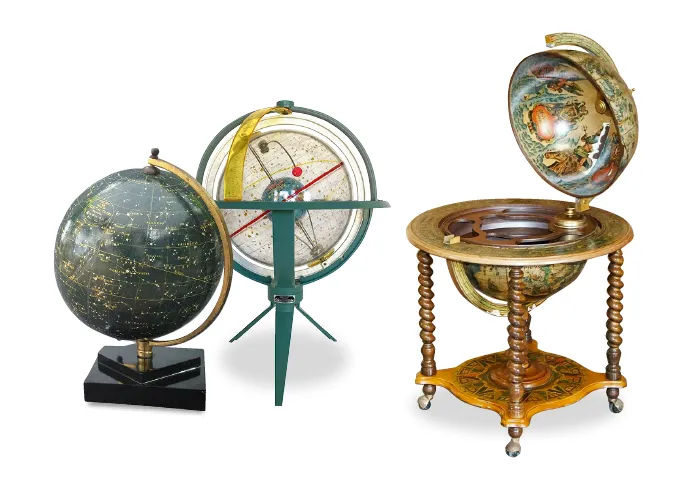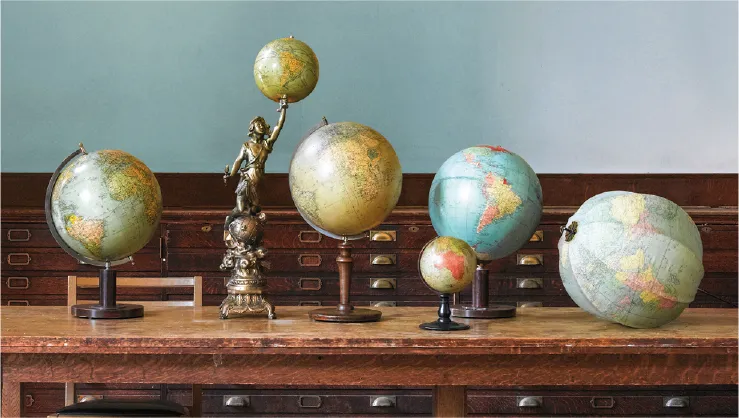Classrooms aside, I can’t think of anything more appealing than a handsome antique or vintage globe. Price-wise, they suit all pockets. Although the finest, rarest examples – often of historical importance – can change hands for many thousands of pounds, 20th-century ‘vintage’ globes are still incredibly affordable. Lacking that crucial rarity factor, perhaps, but still decorative objects in their own right.
Globes come in two forms: terrestrial (covering the Earth) and celestial (representing the constellations of the night sky). The word ‘globe’ comes from the Latin globus, meaning ‘sphere’. No terrestrial globes appear to have survived from ancient times.
It’s thought that the oldest is the ‘Erdapfel’ (German for ‘Earth Apple’), made by Martin Behaim, the textile merchant and cartographer, between 1490–1492; now in the collection of the Germanic Museum, Nuremberg. Behaim finished his beautifully painted globe before Columbus returned from his celebrated voyage, so it doesn’t include the Americas.
You might also like decorating with vintage school charts
Traditionally, globes are made from strips of paper – either printed or painted – glued onto a sphere, usually made of wood. The globe is raised on a stand, and the brass meridian holds the globe in position. It is engraved with a series of numbers: from 0° at the equator to 90° at either pole.

Early globes are precious, desirable artefacts, prized by collectors with deep pockets; genuinely scarce and rarely appearing for sale at auction, with most surviving examples in museums and private collections. In 2008, a pair of stunning 17th-century library globes by Willem Janszoon Blaeu (1571–1638) – decorated with sea monsters, the Great Wall of China and the signs of the Zodiac – fetched €793,000 at Christie’s (est €200,000–€300,000); at the time, the most expensive works of art to have been sold at auction in the Netherlands.
You might also like collecting school prints
Less scarce, though still eminently desirable, are globes from the 18th and 19th centuries. At Peter Francis Auctioneers, a pair of Cary’s 17in celestial and terrestrial library globes (1816) sold for £50,000 in
the spring of 2013. At the more affordable end of the spectrum, vintage globes can be found in local auction houses, junk shops and flea markets.
Dating 20th-century globes is relatively easy: a knowledge of shifting geographical boundaries and geopolitical developments helps. Jamaica, for example, gained her independence from Britain in 1962, and the new state of Israel appeared for the first time in 1948.

The Geographia Map Company (founded 1911) made a series of attractive globes, which regularly turn up at auction. The globes feature stepped ‘jelly mould’ bases in the Deco style, produced in colourful Bakelite. Philip’s celestial globes are slightly more unusual, and a 12in example in decent condition sold for £130 at Plymouth Auctions this April.
I’m currently saving up for a ‘Torica’ celestial globe: a funky 1960s astronomical table-piece manufactured in transparent plastic by the Tokyo Physical Instrument MFG. Co. Ltd of Japan. This futuristic globe was an educational tool for students of the night sky and could make basic astronomical calculations. It also happens to be highly decorative. In May 2022, at Hansons, a lucky buyer secured an example in good condition for £150.
Find out what the difference between vintage and antique is here.

